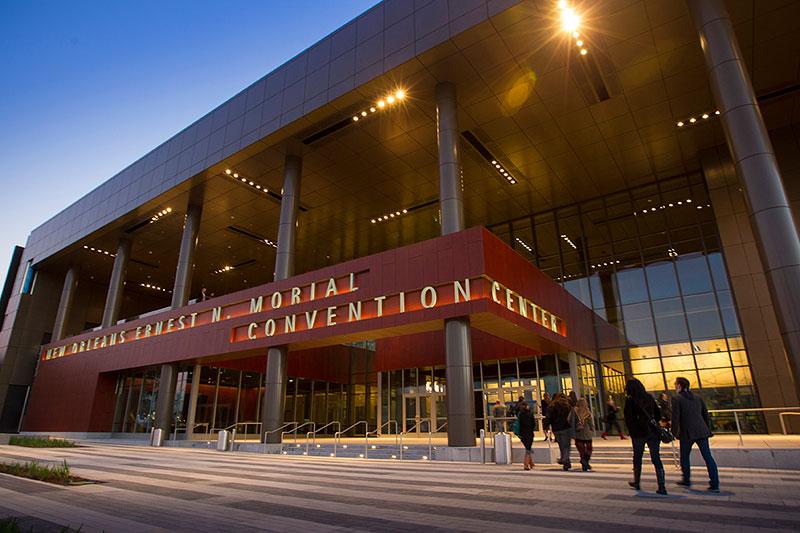Keeping it cool: MBAs help Convention Center find its temperature sweet spot

In the meetings and convention business, few factors impact the guest experience more immediately than temperature.
The New Orleans Ernest N. Morial Convention Center prides itself on ensuring the comfort of its more than 800,000 annual visitors, but as a LEED Gold Certified building, the center is also committed to reducing its carbon footprint and saving energy.
To strike that delicate balance between comfort and sustainability, the Convention Center partnered with the Freeman School and a team of second-year MBA students for a temperature study.
“There’s not a lot of feedback from people in the building about temperature. We wanted data — instead of opinions — on what the right temperature should be."
Linda Baynham, director of sustainability and corporate social responsibility, New Orleans Ernest N. Morial Convention Center
The project was part of the Impact Capstone, a project-based experiential learning course that puts MBAs to work addressing real-world social and environmental problems.
The Convention Center has worked with consulting engineers Green Coast Enterprises since 2018 to reduce energy use and track sustainability efforts, but it had little data from building users on the interplay between temperature and comfort level. To get that data, the Convention Center asked the MBA students to conduct a live survey of building occupants.
“We were interested in learning if changing the temperature in the building could save energy, but first we wanted to find out how attendees in the building felt about the temperature,” says Linda Baynham, the Convention Center’s director of sustainability and corporate social responsibility. “There’s not a lot of feedback from people in the building about temperature. We find that people often feel chilly in the building, but we wanted data — instead of opinions — on what the right temperature should be.”
At last year’s Tulane Business Forum, an annual event of the Tulane Association of Business Alumni that draws more than 500 guests to the Convention Center, the MBA students — Samantha Rubin, Giannis Tsahageas, Nathan Krippner, Sebastian Witte and Sarah Adofo — surveyed attendees to get their firsthand impressions of the temperature and comfort level in the building.
“Since the Convention Center was already working with Green Coast to do more of the hard data analysis, we were tasked with providing them with things people were actually saying when they were in the building,” says Rubin (MBA ’25). “So qualitative data to support the quantitative data.”
The students surveyed about 100 people — roughly 20% of attendees — to get their responses to questions about their comfort level and combined that with real-time temperature readings at the locations the surveys were being completed.
“We got comments from people like, ‘I’ve been to the Convention Center before and it’s always cold, so I knew I needed to bring a jacket. That’s why I wasn’t uncomfortable this time,’” Rubin says. “The numbers don’t really show you things like that, so I think that’s what Linda was looking for with this project.”
The students then ran a regression model to predict how changes in temperature would influence attendee comfort. They ultimately identified 70.6 degrees — slightly warmer than the Convention Center’s setpoint of 70 degrees — as the temperature that delivered the most comfort, but they noted that the biggest factor affecting comfort by far was whether or not the attendee was wearing a jacket. Attendees with jackets were comfortable at lower temperatures whereas those without were comfortable at higher temperatures.
The students’ findings were in line with ASHRAE standards, the international guidelines for HVAC systems that define acceptable thermal conditions as those in which at least 80% of occupants are comfortable, but Rubin says their report focused more on future recommendations than their specific results.
“Surveying 100 out of 500 people is fairly good, but it’s still a small sample size and not really generalizable,” Rubin says. “In our report, we recommended conducting more surveys, including at different times of the year, we created a feedback survey they can use at future events, and we discussed AI tools that can be used centrally to adjust temperatures and improve efficiency.”
Baynham says she was pleased with how the project turned out.
“The students were really great,” she says. “It was a big project, but they were professional, they did great research, and their presentation was very well done. Hopefully, we can do another project in the future.”
Interested in advancing your education and/or career? Learn more about Freeman’s MBA programs. Find the right program for you.
Recommended Reading
- Meet the MBA Class of ’27: Andrew Karcher
- Meet the MBA Class of ’27: William Baird
- A Family Affair: Tulane’s Executive MBA Brings Parents and Children Together
- Daniel Mochon: Navigating the Noise
- EMBA travel stipend helps execs get to class
- How to Choose an MBA Concentration
- What Will You Learn in an MBA Curriculum?
- Part-Time vs. Full-Time MBA
Other Related Articles
- Every dog has its day at alums’ bar and restaurant
- Embracing Business Futurism: A Conversation with Cliff Farrah
- Meet the MBA Class of ’27: Cameron Pyne
- Meet the MBA Class of '27: Mark "Rennie" Merhige
- EMBA Marine rises through the ranks
- Meet the MBA Class of '27: Hunter McGehee
- Meet the MBA Class of '27: Dee Parekh
- Alum creates scholarship to give students ‘freedom to take risks’
